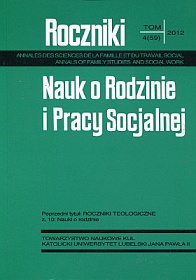Use of Internet Pornography by Secondary School Girls in the Context of Family Factors
Abstract
The aim of the present investigations was to answer the questions of (a) whether and in the sphere of what family factors there are differences between secondary school girls using and not using Internet pornography and (b) whether and what kind of relations obtain between the dimensions of Internet addiction and family factors in a group of girls using Internet pornography. Material: The participants were 186 secondary school girls aged 16-19 years. Methods: The study was conducted using Young's Internet Addiction Test (IAT) for assessing the severity of Internet addiction, and the following instruments by Pawłowska and Potembska: the Internet Addiction Assessment Questionnaire, the Disturbed Family Relations Questionnaire, and a Personal Inquiry Form. The Internet Addiction Assessment Questionnaire consisted of five scales, I. Acceptance, II. Games-Need for Aggression and Power, III. Computer Addiction, IV. Internet Addiction, and V. Pornography. The Disturbed Family Relations Questionnaire was made up of scales for I. Violence, II. Overprotectiveness, III. Coalition with the Mother, IV. Lack of Acceptance-Rejection, and V. Indifference. Results and conclusions: On the basis of the obtained results, the following conclusions were formulated: 1. The girls who used Internet pornography, more often than the girls who did not use it, had experienced violence and rejection in the family, and had taken over the role of guardians in their relationships with their mothers. 2.Increased symptoms of addiction to the Internet, aggressive computer games, and Internet pornography, as well as the search for acceptance and understanding from people contacted online co-occured with violence, rejection, and indifference experienced in the family, assumption by the child of the role of guardian and protector of the mother, and fear of adulthood.
References
Ary D. V., Duncan T. E., Biglan A., Metzler C. W., Noell J. W., Smolkowski K.: Development of Adolescent Problem Behavior, „Journal Abnormality Child Psychology” 27(1999), z. 2, s. 141-150.
Braun-Courville D. K., Rojas M.: Exposure to Sexually Explicit Web Sites and Adolescent Sexual Attitudes and Behaviors, „Journal Adolescent Health” 45(2009), z.2, s. 156-162.
Carroll J. S., Padilla-Walker L. M., Nelson L. J., Olson C. D., McNamaraBarry C., Madsen S. D.: Generation XXX. Pornography Acceptance and Use Among Emerging Adults, „Journal Adolescents Research” 2008, nr 23, s. 6-30.
Cooper A.: Sexuality and the Internet: Surfing Into the New Millenium, „CyberPsychology & Behavior” 1998, nr 1, s. 181-187.
Flander G. B., Cosic I., Profaca B.: Exposure of Children to Sexual Content on the Internet in Croatia, „Child Abuse Neglecting” 33(2009), z. 12, s.849-856.
Guerreschi C.: Nowe uzależnienia, Kraków: Wydawnictwo Salwator 2005.
Izdebski Z.: Seks w Internecie, TNS OBOP 2005.
Ko C. H., Yen J. Y., Liu S. C., Huang C. F., Yen C. F.: The Associations Between Aggressive Behaviors and Internet Addiction and Online Activities in Adolescents, „Journal Adolescent Health” 44(2009), z. 6, s. 598-605.
Koo H. Y., Kim S. S.: Relationships Among Cybersex Addiction, Gender Egalitarianism, Sexual Attitude and the Allowance of Sexual Violence in Adolescents, „Taehan Kanho Hakhoe Chinese” 37(2007), z. 7, s. 1202-1211.
Mesch G. S.: Social Bonds and Internet Pornographic Exposure Among Adolescents, „Journal Adolescents” 32(2009), z. 3, s. 601-618.
Park S. K., Kim J. Y., Cho C. B.: Prevalence of Internet Addiction and Correlations with Family Factors Among South Korean Adolescents, „Adolescence” 43(2008), z. 172, s. 895-909.
Pawłowska B., Potembska E.: Właściwości psychometryczne Kwestionariusza do Badania Uzależnienia od Internetu (KBUI), „Badania nad Schizofrenią” 10(2009), z. 10, s. 310-321.
Pawłowska B., Potembska E.: Właściwości psychometryczne Kwestionariusza do Badania Zaburzonych Relacji w Rodzinie (KBZRR), „Current Problems of Psychiatry” 11(2010), z. 2, s. 119-126.
Yen J. Y., Yen C. F., Chen C. C., Chen S. H., Ko C. H.: Family Factors of Internet Addiction and Substance Use Experience in Taiwanese Adolescents, „CyberPsychology & Behavior” 10(2007), z. 3, s. 323-329.
Young K. S.: Caught in the Net: How to Recognize the Signs of Internet Addiction and a Winning Strategy For Recovery, New York: John Wiley 1998.
Young K. S.: Internet Addiction: Symptoms, Evaluation and Treatment, [w:] Innovations in Clinical Practice: A Source Book, red. L. VandeCreek, T. Jackson, Florida: Professional Resource Press 1999, s. 19-31.
Young K. S.: What is Cybersexual Addiction?; http://netaddiction.com

